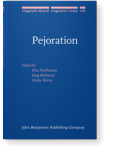Hyun Jung Koo
List of John Benjamins publications for which Hyun Jung Koo plays a role.
2023 Chapter 8. Repetitive constructions and stance-marking: The case in Korean Discourse Phenomena in Typological Perspective, Barotto, Alessandra and Simone Mattiola (eds.), pp. 201–227 | Chapter
Korean has highly formulaic patterns of repeating a sentence two or more times with a variation of speech level indicated by the sentence-final particles. The repetition usually involves progressive downward modulation of the speech level from more formal to less formal. The repeated sentences… read more
2021 Chapter 3. On divergent paths and functions of ‘background’-based discourse markers in Korean Studies at the Grammar-Discourse Interface: Discourse markers and discourse-related grammatical phenomena, Haselow, Alexander and Sylvie Hancil (eds.), pp. 77–100 | Chapter
This paper analyzes two polyfunctional discourse markers (DMs) in Korean, kulssey and kuntey, which share lexical and grammatical sources, with the meaning of ‘at the time’ for kulssey and ‘at the place’ for kuntey. They denote the background of an action/event (‘in such circumstances’), which is… read more
2017 Multifaceted gustation: Systematicity and productivity of taste terms in Korean Food and terminology: Expressing sensory experience in several languages, Temmerman, Rita and Danièle Dubois (eds.), pp. 38–65 | Article
Korean has a large number of taste terms and the paradigm is continuously expanding since the lexicalization operates systematically on a few robust principles. Based on the taste terms collected from lexicons, dictionaries, web-postings, and elsewhere, we classified the terms and analyzed the… read more
2016 Pejoratives in Korean Pejoration, Finkbeiner, Rita, Jörg Meibauer and Heike Wiese (eds.), pp. 301–324 | Article
This paper analyzes the patterns of pejoration-marking in Korean. The speaker’s pejorative attitude is realized as diverse morpho-syntactic devices (Koo 2004). The most common devices of pejoration-marking fall under the following six categories classified according to the semantics of the source… read more



